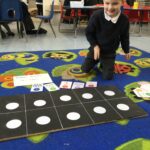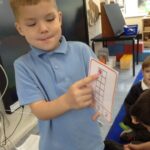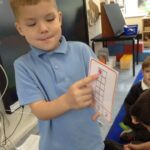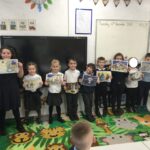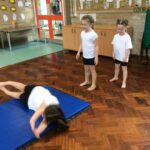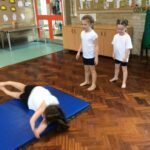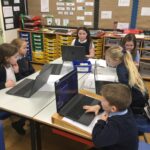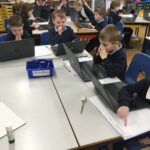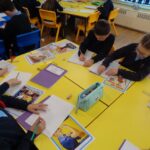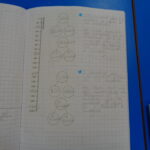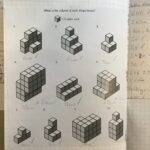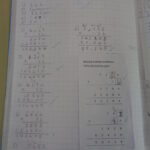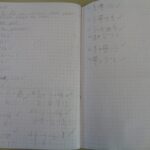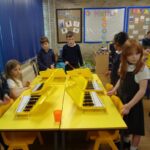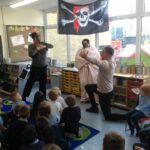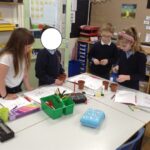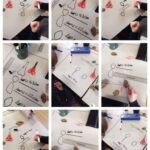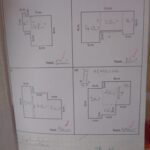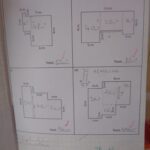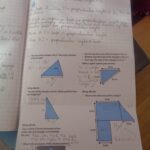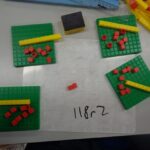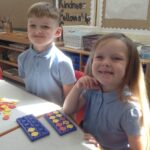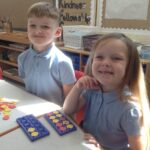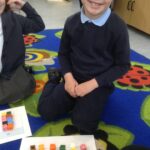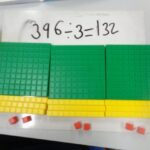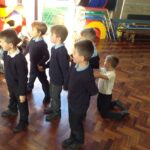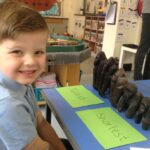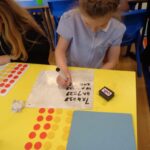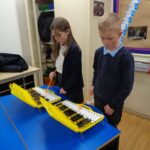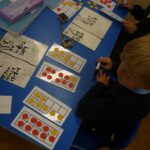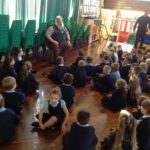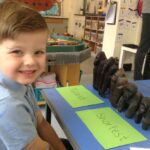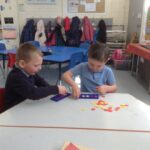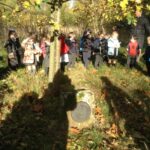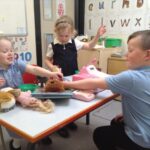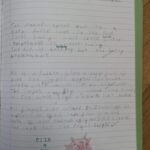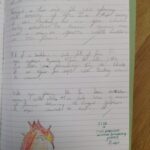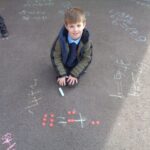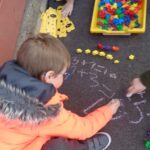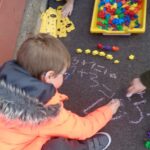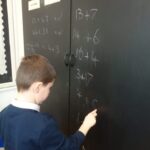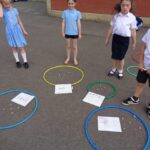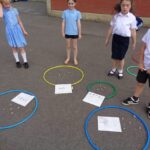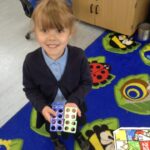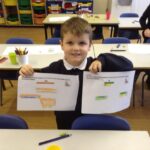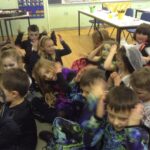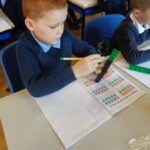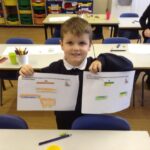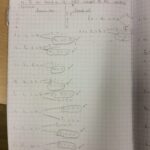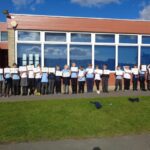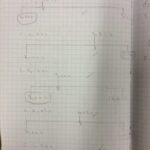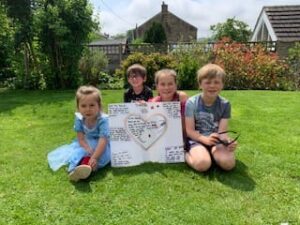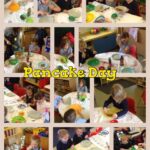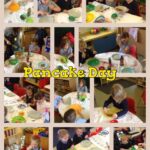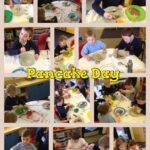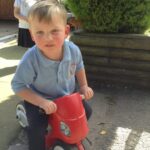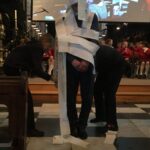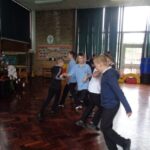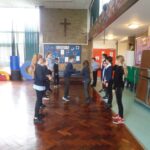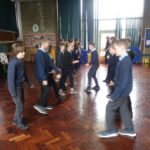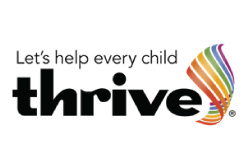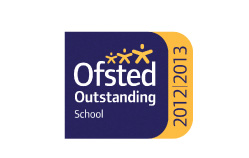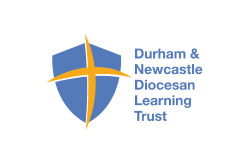Archived Numeracy 2022-2023
Nursery (Opal Learning Zone)
Understanding different sizes – The children have been working conscientiously to represent numbers from zero to five. One way the children do this is by having practical challenges to complete. For example, below Nathan has been challenged to order three different bowls after reading the story of Goldilocks and the Three Bears. This task promoted a range of skills including one-to-one counting, sorting size and representing a number accurately.
Reception – with Mr. Storey (lead), Mrs. Heslop-Stead
Number Bonds to 10 – The children have shown increasing confidence with their umber bonds to ten. Over the year we have worked hard to understand the numerical make up of numbers zero to ten and have now been studying numbers that bind together to make ten. Using a tens frame the children created a range of numbers before representing the number sentence using number cards.
How can we represent numbers? – We have been quick to begin number sessions in the Amethyst Learning Zone. Using inspirational videos from the Number Blocks the children have been busy using a range of resources to represent different umbers. The children also used Stem sentences to explain their number understanding to their peers.
Year 1 – with Mr. Storey
Greater than / Less than – Our practical approach to Year 1 Maths is proving to have great success. In our latest topic the children have been using inequality symbols to make comparisons between quantities. The children have showed great understanding and are all now using greater than, less than and equal to confidently.
Year 2 – with Miss Hunter-Purvis
Using our skills in a real-life context – One of our big maths blocks this term in Year 2 has been multiplication and division. We have been doing lots of times table practice in class and as part of our homework to develop our times tables knowledge. To finish our block, we answered lots of questions with a real-life context to test our skills. These included two-step problems which are even more tricky.
Finding the Difference – We have been finding the difference between numbers in Year 2 maths. We set a challenge for our partner with two different sized cube towers. They had to find the difference between the numbers then write the corresponding subtraction expression.
Multiplication and Division – Our latest topic in Year 2 maths is Multiplication and Division. We have been learning all about unequal and equal groups, arrays, factors and products, and counting in 2s, 5s and 10s. We have recently moved on to practicing our 2 times tables and this week, the children got to use Times Tables Rockstars for the first time to practice. It was a bit tricky to get used to but we are looking forward to using it more in class to help us.
Year 3 – with Mr. Clarke (lead), Mrs. Parvin, Miss Wilkinson
Year 4 – with Mr. Clarke
Column Addition and Subtraction – Year 4 have recapped and revised learning column addition and subtraction of the first half term. They have identified the place and value behind the numbers and why they are set out like they are. They’ve then applied this knowledge and the methods to solve a range of problems.
Four-Digit Numbers – Year 4 have been looking in depth at four-digit numbers, identifying ways to represent them with various methods of partitioning to encourage quick recognition of the place value of the different numbers. They have moved on to look at rounding and solving problems using their knowledge of these higher numbers.
Year 5 – with Mrs. Green
Multiplying Three Numbers and Volume – We have combined using the skill of multiplying three numbers with understanding how to calculate volume. We started out block using manipulatives to help us understand cm3. We then moved onto looking at shapes that included cubes and either counting or multiplying to calculate the volume. Once we were secure with the concept of volume we moved onto calculating the volume of compound cuboids. Year 5 have worked very hard with this tricky concept.
Part-Part-Whole Understanding – We have been using Cuisenaire Rods in Maths to help us to understand the relationship of Part-Part-Whole. The children were able to form their equation based on the rods and worked well in partners.
Year 6 – with Miss Hepple
Maths Skills – Year 6 have been working extremely hard in maths to link fractions, percentages and decimals. This is not an easy concept and the children have shown their Diamond Learning Zone power of problem-solving to tackle some very tricky questions! Alongside this, we have been practising a range of arithmetic and reasoning questions that will help us with our upcoming SATs!
Long division – We have been extending our knowledge of division and learning how to complete long division questions to find answers with remainders. To extend our learning, we have even been able to convert our remainders into decimal fractions and proper fractions to complete problem-solving questions.
Multiplication – In Year 6, we have been practising our 4-digit by 2-digit multiplication. We have worked hard to use our knowledge of times tables to help us with this method and apply our skills to tricky missing number problem-solving questions.
Adding and subtracting fractions – Year 6 have been busy adding and subtracting fractions ready to move on to multiplying and dividing. The children have used their problem-solving ability to apply this to proper fractions, improper fractions and mixed numbers.
Numbers to 10,000,000 – Year 6 have been focusing on numbers up to 10,000,000. They have worked very hard to explore lots of different mathematical concepts such as common intervals, conversions, written and mental methods, comparison between numbers, adding and subtracting across boundaries, rounding and lots of problem-solving!
Archived Numeracy 2021-2022
Opal Learning Zone
How can you represent numbers? – The children continue to thrive with their number. We have been working hard to recognise numbers zero to five and have started using a range of techniques to represent them. This week we have been matching numerals to tens frames and numicon as we create a metal image of numbers in our head. We have also introduced a daily maths challenge for the children. This challenges the children to try and match a representation of a number to a numeral as a way of self-registering on a morning.
The Mastery Approach – The mastery approach to maths is having a huge impact with number in the Opal Learning Zone. The children split into two groups where we concentrate on simple number skills and concepts. The children in Mrs. McArdle’s group this week have been understanding more than and less than. Utilising the practical resources has been brilliant to improve maths knowledge and also communication and language skills as children attempt to explain their understanding with their peers.
Amethyst Learning Zone
Maths Concepts – We have been exploring a variety of concepts in math this term including arranging items in order of tallest to shortest.
How can you represent numbers 11-20? – Our practical approach to number continues to engage our children, as we aim to become Year 2 ready. This half-term we have started to recap numbers 11 to 20 using a range of apparatus to support us in representing the numbers. The children have used a concrete and pictorial approach which has illustrated their solid understanding. Next week we will start to use our Maths books to solve number problems using numbers beyond 10!
Mastery for Maths – It has been a fantastic first half-term for our Mastery approach to Maths. The children have been understanding number with a focus on how numbers can be made up. Using a range of equipment, the children have been challenged to illustrate how numbers can go together to create a different number. Our vocabulary continues to improve with children able to discuss one more, one less and use addition and subtraction in a verbal number sentence.
Sapphire Learning Zone
How can we replicate shapes using multilink cubes? Y1 – Continuing our manipulating shapes topic, the Sapphire Year 1s tried replicating different shapes using different concrete objects. Some of the shapes were tricky to copy but we enjoyed the challenge.
Can we share all numbers equally? Y2- The Year 2s have done a lot of multiplying and dividing this half term. One of the investigations we looked at was whether we could share all numbers equally. We did this using plant pots and counters and we found that only even numbers can be shared equally between 2.
Year 1 Maths – Our Sapphire Learning Zone Year 1s have been learning all about 2D and 3D shapes. We started by manipulating 3D shapes into our own patterns and this is what we came up with! We even managed to create Neil Armstrong’s Apollo 11 rocket that we have been learning about in History.
Year 2 Maths – In Year 2, we have been focussing on addition and subtraction of 2-digit numbers. We have being using ten frames so that we can visually see what happens to the numbers when we are subtracting and adding.
Numbers to 100 – In Year 1, the children have been investigating numbers to 100. They have had lots of fun both indoors and out, recognising, making and writing numbers. We have looked at the value of numbers using dienes and other concrete materials.
Groups of 10 – In Year 2, the children have been exploring groups of 10, using a range of apparatus to understand the concept and to become confident within numbers and their values.
Ruby Learning Zone
Time Tables – Both year groups in Ruby have been investigating times tables this term. The Year 3s have been looking at the 2x, 4x and 8x tables and also exploring how they have similarities. The Year 4s have been working with the 3x and 6x table. The children have increased their knowledge, begun to make comparisons and spot patterns and developed their mastery of the subject areas.
Place Value – Year 3 children in Ruby Learning Zone have been focusing on place value of numbers up to 1000 and have begun applying this to solving column addition problems.
The Year 4 children have also been working with column addition, though they are working with 4 digits. They have also moved on to column subtraction and finding different methods to help them solve real world problems.
Maths Concepts – Both year groups have worked hard on their respective Maths topics this term, using physical objects to help show their understanding of number, place value and addition and subtraction.
Emerald Learning Zone
Perimeter – The year 4 children have started to learn about measuring perimeter. We found lots of objects to measure on our tables using string and our rulers. It was a great lesson with lots of fantastic discussion about the most accurate way to measure the perimeter.
Walking 1,000m – Our Year 4s have been looking at the number 1,000 this week and linking it to real life context. We went for a 1,000m walk and placed a marker every 100m linking our learning to the stem sentence ‘There are ten one hundreds in one thousand’
Diamond Learning Zone
Year 5 Maths – Year 5 have had a very busy half term learning all about multiplication and division and moving on to area and scaling. The children began by using dienes blocks to help solve tricky multiplication and division questions that involved remainders and can now confidently do this using the short method! They then began their new topic (area and scaling) in which they used centimetre squares to calculate the area of objects from around the classroom.
Year 6 Maths – Year 6 have been faced with some very tricky maths this half term! I am very impressed with how hard the children have worked to solve problems on the perpendicular height of a triangle and finding the area of a range of different shapes.
Negative Numbers – Year 5 have been focusing on negative numbers. We have looked at them in a range of different contexts and used our knowledge to tackle more challenging reasoning problems.
Numbers up to 10,00,000 – Year 6 have been focusing on numbers up to 10,000,000. We have been recognising and creating numbers that contain place-holding zeros and comparing numbers using our greater than, less than and equal signs.
Archived Numeracy 2020-2021
Opal Learning Zone
Numbers everywhere! – In the Opal Learning Zone we have recently enhanced the unit to ensure number is apparent in all areas. The children have been captivated with this approach as it allows them to have a deepened level of understanding for number. For instance, the children use counters to pay for snack which promotes number recognition and one-to-one counting. Furthermore, the children are using number through their imaginative play. Here some of the children are accessing the shop and utilising their new-found number vocabulary.
Amethyst Learning Zone
Mastery for Maths – It has been another exciting week in the Amethyst Learning Zone as we continue to improve our number knowledge. The children have been focussing on teen numbers and the importance of being able to represent them in a range of ways. The use of Numicon, tens frames and pictorial recording have allowed the children to have a deeper understanding of number. The pictures below show how the children are able represent numbers and also explain what they have created.
Sapphire Learning Zone
Engaging with Numbers – Maths is both interactive and engaging in the Sapphire Learning Zone. The children have been taking their learning outside to record their work using chalks to record and concrete apparatus to help show their understanding. The children have been having fun completing the daily challenge activities on our maths wall. They have been setting challenges for one another too.
Ruby Learning Zone
Multiplication – This term the children in Ruby have been looking at different multiplication tables and identifying the different patterns and systems that are involved. The children have worked hard to show their understanding in lots of different ways.
Emerald Learning Zone
Division with remainders – This half term we have had a huge focus on division in the Emerald Learning Zone. Today we were looking at the concept when the calculation does not represent the complete solution. The class went outside to investigate how many tents a scout group would need to fit in all of their children. The children were able to realise that we would need an extra tent as there was one remainder. We then took this learning back to the classroom and explored the concept further.
Diamond Learning Zone
Can I find all of the possible combinations by using concrete materials? – The children in Diamond Learning have been continuing to use concrete materials to help them solve mathematical questions that are often challenging to work out in our heads. The children in year 6 have been working hard on finding all of the possible combinations from a given maths problem.
September 2020- February 2021
Class 1
Math Mastery – In Maths, we have continued to use a range of concrete, pictorial and abstract methods to develop our understanding of number. We have used Numicon, cubes, part-part-whole models, ten frames and Cuisenaire rods to help us learn. Following the Mastery Approach, we have thoroughly investigated the composition of numbers 6-10, including odd and even numbers. We have also used iPads to further develop our understanding.
Understanding numbers – In maths, Class 1 have been learning about ‘fewer’ and ‘more’ and have been exploring part-part-whole models. They love learning new ways to solve problems.
Class 2
Resources to solve problems – In maths, we have been using a range of concrete resources to help support our learning. We have become confident using ten frames, cubes, part-part-whole models and bar models. The children are encouraged to use the resources to help explain their thinking when solving a maths problem. We have been carrying out lots of practical maths to problem solve and explain our reasoning behind some tricky problems.
Class 3
100 – This half term, the children in Class 3 have been lots of work around the number 100. We have used part whole models and bar models to work out what numbers we need to add or takeaway to get to 100. The children have had lots of fun doing this and really enjoy their quick fire questions!
Class 4
Addition & Subtraction – The children have been refining their skills in addition and subtraction as well as building on their knowledge of place value. We have used a range of representations such as; part-part whole models, bar models, place value tables and number lines to support out working out.
Negative numbers – We decided to take our negative number lesson outside today. Each child was given a number, some negative and some positive. They then had to work together to put themselves in the correct order. They did it in under 2 minutes!
Class 5
Negative Numbers – In class 5 we have been working hard to improve our reasoning and problem-solving skills. The children have been using their knowledge of negative numbers and applying these to more tricky, challenging questions. We have been using a range of representations, such as number lines and information charts, to help us.
Maths Challenge – On mornings when numeracy is on the curriculum, our children enter school to be challenged by a selection of mathematical questions. The children really enjoy this work as it’s a fun way to start the day and they really like to try and beat their previous score. Individual maths fact books are used to support this work with new topics and objectives added regularly. Class targets are to score half marks if possible.
Numeracy Objectives – Class 5 have worked on 3 objectives. We began by changing numbers into words before which allowed the children to return to school and realise everyone can achieve their personal targets. The children then moved into Column Addition calculations which was designed to refresh knowledge and understanding as well as raise confidence in each child. We extended this objective by including a decimal point. Every child achieved their target.
Policy:
Staff Co-ordinator: Mr. S. Myers
Link Governor: Ms. S. Callaars-De Gruyter
Statement of Intent:
Class 1
26.9.19- In Class 1 we are making our mental maths sessions active a few times a week now. This week we went to the hall and used cones to help us with our place value skills. We had a great time and all agreed it was a great way to count 10s and 1s. We had cones which had different values and had to use quick addition skills to work out which number we had made. It was really fun.
23.9.19- In maths we have been solving some problems and learning how to write the number words to go with the numerals which we already know. We are going to get better and better at it.
Class 2
One of our topics in maths this Spring half term has been odd and even numbers. We decided to make a reminder of the skills we have learnt by making some monsters. First we had to create our monsters and then record the different parts into the odd or even group. They are up in the classroom as a constant reminder.

In maths we are continuing to work on our quick fire maths. We have been practicing our multiplication skills, using arrays to help us. We are becoming very efficient using money, including £ and p. We have enjoyed using coins to make amounts and give change, after using our addition and subtraction skills we learnt last half term.
A big focus this half term has been place value and the addition and subtraction of numbers. We have been having fun using our skills in different ways using both formal written methods and by using apparatus and games to help us perfect our skills.
Class 3
19.12.19- The children in Class 3 have been working hard to solve the mystery of the missing Christmas pudding! We used lots of maths skills such as multiplication and division to solve the clues!
10.10.19- The children in Class 3 have been working very hard on their addition and subtraction. We have been using place value grids to work out the answers to our number sentences. As a class, we went outside and used chalk and cones to create a place value grid on a bigger scale. The children had lots of fun moving their ‘place value counters’ to find the answers.
Class 4
This half term we have been focusing on our place value and addition and subtraction. We have used a number of different questioning techniques to get the children thinking to ensure that they can problem solve and reason.
Class 5
Column Subtraction- Numeracy – Class 5 -Column Subtraction 2019
Grid Method- Numeracy – Class 5 -Grid Method 2019
Maths Fact Books
Mental Maths

Number and word comparisons- Numeracy – Class 5 -Number and word comparisons 2019
Word Problems- Numeracy – Class 5 -Word Problems 2019


